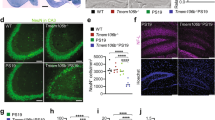Summary.
Alzheimer’s disease-like neurofibrillary pathology is neither seen in rodents nor in transgenic animals expressing the disease causing mutant human APP or mutant human presenilins. Whether the absence of this pathology is due to inability of the murine tau to self assemble into filaments or due to some other factors is not understood. In this study, we compared recombinant murine and human taus in their ability to form filaments by AD-like hyperphosphorylation in vitro. Human and murine taus, 0N4R, were generated as recombinant proteins and phosphorylated with rat brain extract as a source of protein kinases. We found that murine tau could be hyperphosphorylated to similar stoichiometry and manner as human tau. Upon hyperphosphorylation, murine tau was able to self polymerize into bundles of paired helical filament- and straight filament-like morphology. The filaments obtained from self assembly of murine tau closely resembled those formed from identically treated human tau. Moreover, like human tau, 60–70% of murine tau aggregated on hyperphosphorylation.
Similar content being viewed by others
Author information
Authors and Affiliations
Rights and permissions
About this article
Cite this article
Chohan, M., Haque, N., Alonso, A. et al. Hyperphosphorylation-induced self assembly of murine tau: a comparison with human tau. J Neural Transm 112, 1035–1047 (2005). https://doi.org/10.1007/s00702-004-0241-9
Received:
Accepted:
Published:
Issue Date:
DOI: https://doi.org/10.1007/s00702-004-0241-9




